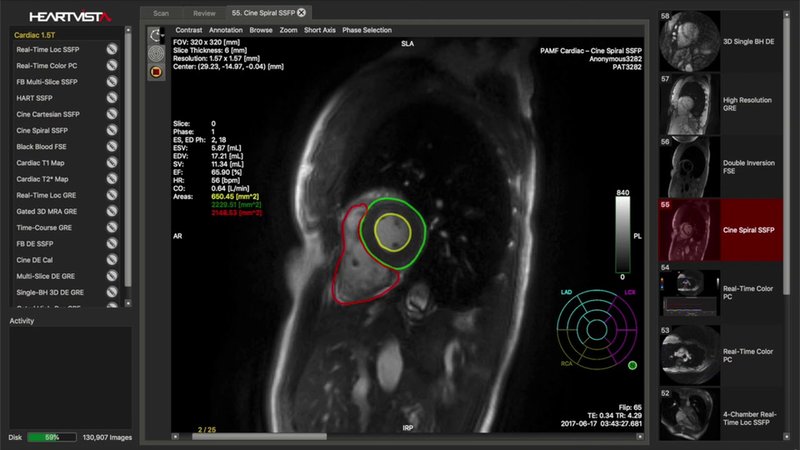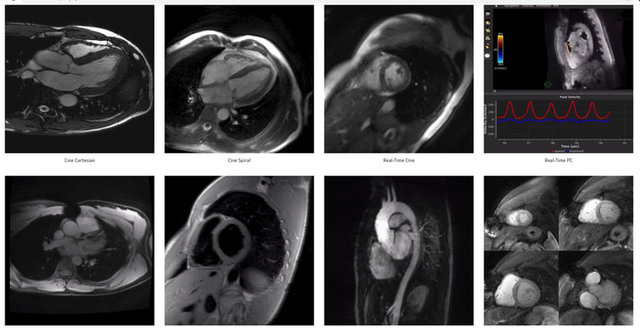HeartVista
OF THEHeart
The Xerox Machine
By Gergana Koleva
With AI technology that takes control of MRI scanners for all the right reasons, HeartVista could be the protagonist in a futuristic science fiction thriller. But for this company, the future is now, brought by an AI-guided cardiac MRI acquisition system that brings the art of scan complexity down to a single click, which allows physicians to connect remotely and control patient exams during a “livestream”, and operates at a scale that enables imaging of multiple patients in a fraction of the time.
Founded two decades ago by a group of scientists at the Magnetic Resonance Systems Research Lab at Stanford University, HeartVista is the emperor of cardiac magnetic resonance (CMR) studies. Its One Click Cardiac MRI Package software is so polyvalent that enumerating its capabilities and functions reads like a cardiologist´s ultimate wish list. Packed with apps for automatic imaging planes localization, real-time recalibration, artifact auto-correction, 4D flow, time-course GRE, and delayed enhancement computation for optimal myocardial contrast, and designed to run on GE and Siemens scanners using customizable one-click protocols – and on many machines at once, if so desired – it provides a long-awaited solution to some of cardiac imaging´s wickedest problems.
In HeartVista´s world, the technology follows the market need, which in the context of CMR is enormous. Considered the gold standard for non-invasive and invasive study of cardiac function and the best test for evaluating ischemia, myocardial viability, and arrhythmic disease, CMRs are highly valued by cardiologists, but involve a laborious and time-consuming process. The procedure can last up to 90 minutes and require up to 300 different clicks that highly experienced lab technicians must make to prescribe the scan images (axes and chambers), create the pulse sequences, scan the planes, and even adjust the patient when necessary.
“We line up the protocol in 15 seconds and activate it with only one click. We employed AI to study what the best human technologists in the world do many times over and once we had all this data, we automated the activity. Prescribing the standard scan images automatically is a dramatic improvement in time and it´s one way our technology helps reduce the time it takes to do a CMR,” says HeartVista CEO Itamar Kandel. He points out that the software also saves time by never stopping to manually adjust parameters or to “play with knobs and controls” to optimize the result, like humans do, but instead is always running and recalibrating according to the set protocol.
As a result, images appear on screen as they are scanned, allowing for faster decision-making and near real-time diagnostics. All told, HeartVista´s technology produces CMRs dramatically faster than traditional scanners and it even enables operators to log on and view the procedure remotely.
“It´s like livestreaming. Sometimes when I go into the lab and see the beating heart on screen in real time, it feels to me like science fiction, what Dr. McCoy from Star Trek would use at his sickbay on board the Enterprise when scanning Captain Kirk.”
But the real magic, Kandel says, is in the numerous possibilities HeartVista´s Cardiac Package raises to scale the output of cardiac imaging labs, and lessen their dependence on highly skilled field technicians – a key constraint in even highly resourced settings – since much of the CMR process can be automated. “We saw a dramatic drop in not only the time that it takes to do a scan, but also in the level of expertise needed. Being able to run the procedure with just one click means you don´t need to have highly proficient technicians that understand both the anatomy of the heart and the physics of the machine. And if you do have technicians that know what they´re doing, they can start managing multiple machines.”
AI-guided MRI scanners


With the One Click Cardiac MRI Package we saw a dramatic drop in not only the time that it takes to do a scan, but also in the level of expertise needed. Being able to run the procedure with just one click means you don´t need to have highly proficient technicians that understand both the anatomy of the heart and the physics of the machine. And if you do have technicians that know what they´re doing, they can start managing multiple machines.
Itamar Kandel, CEO, HeartVista
AI will bring healthcare services to people that do not have a chance of getting it otherwise. And that – MRI for all – is what galvanizes us. That´s what we are trying to do in the world, to positively affect so many millions of people who today don´t have access to this technology.

The appeal of HeartVista´s AI-assisted cardiac imaging software reaches beyond its efficiency and dazzling automation capabilities. It has real impact on patient care, as using that technology means clinicians are not only “upgrading” to a more manageable CMR approach, but also foregoing a far cruder method: fractional flow reserve (FFR). Long considered the go-to method for visualizing the presence and distribution of coronary artery disease, FFR is an invasive diagnostic procedure associated with a higher-than-warranted incidence of revascularization, as demonstrated by an outcome-based study published last year in the New England Journal of Medicine. The research, formally known as the MR-INFORM study, found that non-invasive CMR is just as good as FFR at guiding treatment for patients with stable chest pain, while resulting in 20% fewer catheterizations. Yet, because of its higher technical and knowhow requirements, higher costs, longer scan times, and overall complexity, the use of CMR in cardiac diagnostics has been limited.
This is where HeartVista´s solution comes in. By automating, accelerating, and scaling the process of obtaining a CMR with minimum clinical input required, the company solves the challenge of deploying a diagnostic tool that is superior and far more sparing for patients, but that comes with decidedly higher operator requirements. Kandel says the idea for the core technology that powers the One Click package was germinated long before the results of the MR-INFORM study were known – in fact, while some of HeartVista´s team members were still PhD students at Stanford close to 20 years ago. They had observed the dissonance between the advantages of then-emerging CMR technology and the logistic and technical difficulties physicians had in using it, and decided to do something about it.
“Even though MRI is understood by the scientific and the clinical community to be one of the best tools, for many cardiac diagnoses it is still an unfeasible and impractical solution because its management is so complex. Just a handful of centers even do cardiac MRI, let alone do it in a highly proficient and consistent way. So that was the problem our team decided to tackle, and tackles to this day.”
CMR superiority
After tackling the challenge of making CMR technology more accessible and manageable to physicians, HeartVista looks to do the same for patients. Indeed, amidst its software´s panoply of sophisticated features, perhaps its greatest power is in expanding the universe of patients who previously could not – and now can – get a clear CMR thanks to the platform´s ability to capture premium heart images through arrhythmias and breathing difficulties.
“A lot of the time, MRI patients are not healthy people. Some cannot hold their breath on and off for 15 minutes, so with breathing they create artifacts and distortion in the images. With standard MRIs, the technicians have to either recreate those images or end up with bad images with blurring and motion that render them of low diagnostic value. Similarly, if you are scanning someone with arrhythmia, that creates artifacts and complications in the images that need to be adjusted manually. Our technology solves for all those problems,” says Kandel. Throughout his telling of the company´s story, he highlights the importance of being of service to vulnerable patients – those who cannot benefit from traditional CMR either due to their fragile health status, suffer from claustrophobia, or because they live in countries where skilled technicians are expensive and few and far between.
The road ahead seems wide open. In late 2019, HeartVista received its fifth FDA 510(k) clearance to commercialize its CMR package in the U.S., on the heels of receiving the CE Mark that gives it the green light to market the world’s first AI-assisted CMR solution in Europe. And while Kandel acknowledges the satisfaction his team feels with having arrived thus far, he says the ultimate goal of the company is to reach communities that are all too often left behind by the technological revolution.
“The reason why we are all galvanized and excited about MRI in general is that it is considered the best technology compared to almost anything, yet it´s still not available for a lot of people. It´s not available if you don´t have the money. It´s really expensive even with insurance. It is a complicated technology and it takes a lot of time to run a scan. Most physicians use it for brain and spine images, but they are not using it to its full potential. Our software will create significant benefit for the world because its AI helps MRI scanners work so much faster that it can create a lot of margin and help bring MRI costs down, so we can eventually start to give this technology to the masses,” he reflects. Kandel notes that having spent significant time living in developing countries has contributed greatly to his understanding of the vast unmet medical needs that exist simply because there are not enough healthcare professionals to take care of everyone.
“AI will bring healthcare services to people that do not have a chance of getting it otherwise. And that – MRI for all – is what motivates us. That´s what we are trying to do in the world, to positively affect so many millions of people who today don´t have access to this technology.”
Global ambitions
